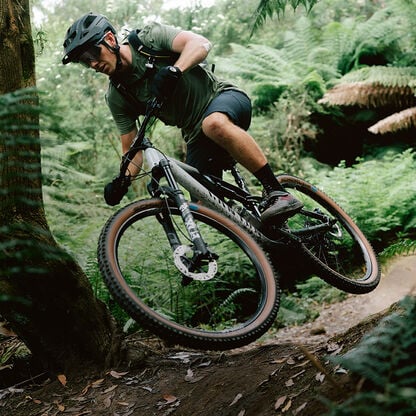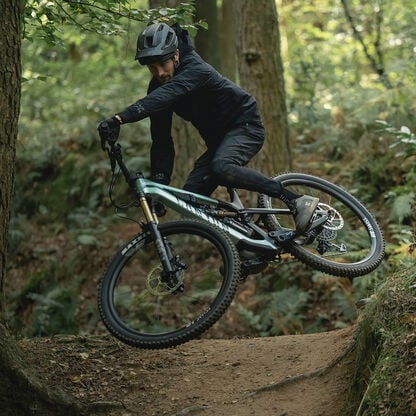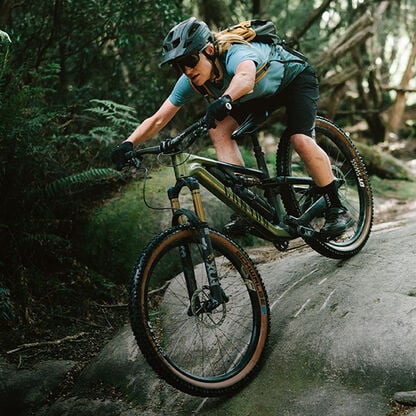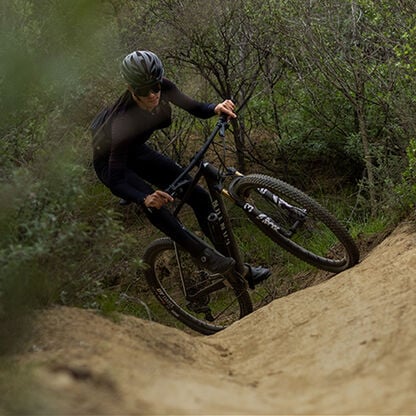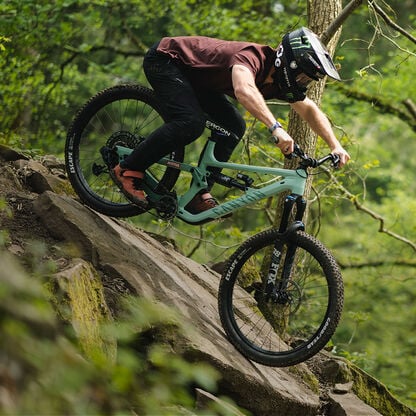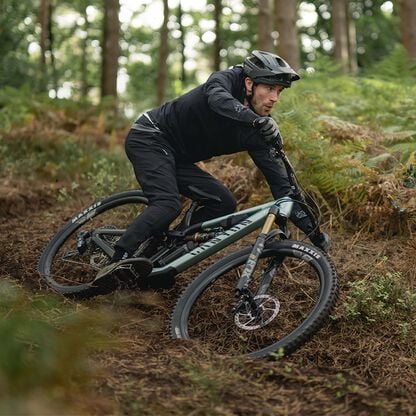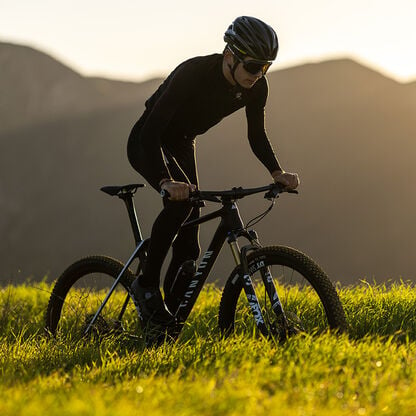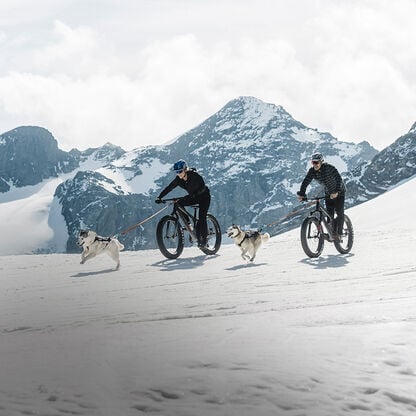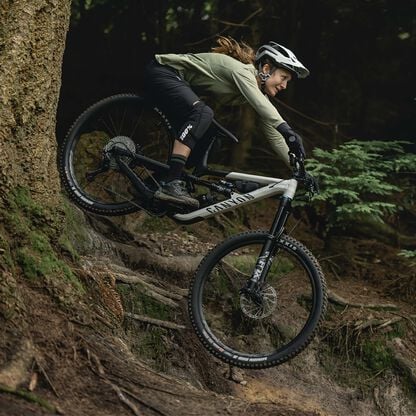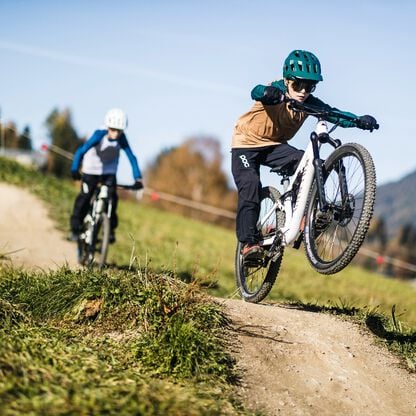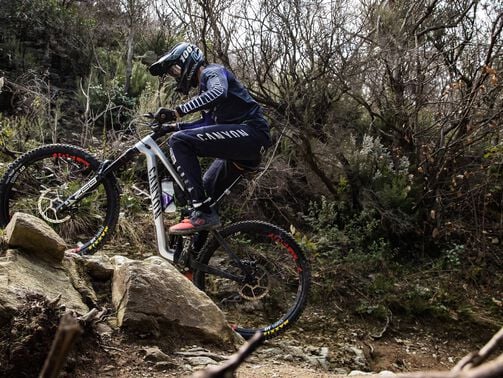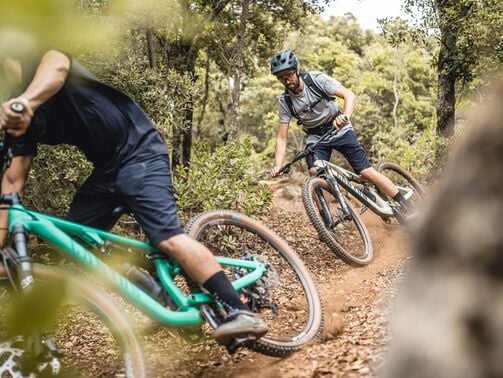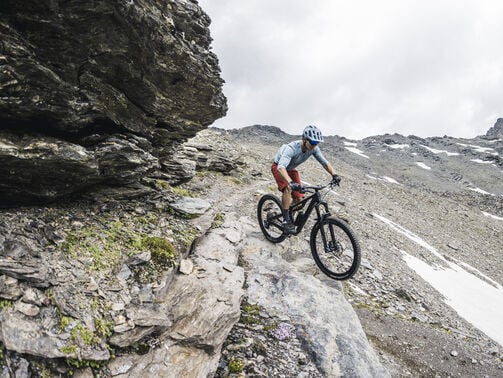Mountain bike groupsets explained: From entry-level to pro
Your mountain bike is not going far without a groupset, but what are they? We break down all the major components from premium to entry-level and what they do.


Contents
Mountain bikers have always had their own language. From the early days of the sport in Southern California, to the globe-travelling circus that is modern World Cup racing, the sport and its riders have always talked with a unique mix of action sports slang and engineering terms.
Coming into the sport, this can be a little intimidating. Do you shred? Are you stoked? And why on earth do you need a groupset so much? We can’t help you with the first two questions, but we do know a thing or two about mountain bike groupsets. This short guide breaks down what a mountain bike groupset is, the differences between different levels and brands, and which one is right for you and your budget.
What components make up a mountain bike groupset?
A bike groupset is a collection of components that form the transmission or drivetrain for your mountain bike. It is the system that uses the power from your legs to turn the rear wheel.
A mountain bike groupset is made up of:
Cranks - these are the arms that you turn with the pedals to move the bike forwards. They may also be referred to as a crankset. Higher end cranks tend to be made from carbon fibre to reduce weight.
Chainring - attached to the cranks is a chainring. This is essentially a cog with a special pattern of teeth to help keep the chain in line. The size of the chainring determines your gearing (how hard or easy the bike is to pedal), a bigger chainring will be harder to turn, while a smaller one will be easier.
Derailleur - working with the shifter, the derailleur moves the chain up and down the cassette to change through the gears. Mounted just ahead of the rear wheel it is the heart of your drivetrain.
Shifter - the shifter is mounted on the handlebar and controls the derailleur to select which gear you which to use.
Cassette - a collection of sprockets or cogs attached to the rear wheel, the cassette is the other half of your gearing. While at the crank a big chainring means a big gear, at the cassette it is the opposite: a big sprocket means an easy gear and a small sprocket a hard gear. High-end cassettes are manufactured and machined much more extensively than their lower end equivalents, so this is one area where you can make a significant weight saving by going up through the levels.
Chain - engineers refer to the style of chain on a mountain bike as a roller chain, but we generally just call it a chain. It connects the crank to the cassette and the derailleur, transferring the power from the rider to the rear wheel.
Bottom bracket - the bottom bracket houses the bearings that allow your crank to spin smoothly. It is separate to the crank because the bearings have a limited lifespan and will need replacing throughout the lifetime of the bike.
Are brakes part of a mountain bike groupset?
You may see some people include brakes in groupsets. We don’t include them because for some of the bikes we make we prefer to offer brakes by a different brand to the one supplying the drivetrain – for example, on our mullet mountain bike, the Torque 5). Generally brakes are not considered a part of the groupset because they are not part of the transmission of the bicycle. You may see that some of our models feature a drivetrain from one manufacturer and brakes from another, so we think it is simpler to not include brakes.
Why are pedals not part of a mountain bike groupset?
While it may seem logical to include pedals in a groupset, this has never been the case. The word groupset is originally a bike industry term to describe a group of components to be sold together, often to a manufacturer rather than consumers. Pedals are matter of individual preference and different riders prefer different types of pedals, which makes it too complicated for a bike manufacturer to cater to all these tastes. The solution has always been to not include pedals in groupsets so customers can buy their preferred pedals later.

Why is there no front derailleur and only one chainring in mountain bike groupsets?
If you own an older mountain bike, or are coming from road cycling, you might expect a bike with multiple chainrings, but today we only sell mountain bikes with a single front chain ring. These are often referred to as 1x drivetrains. There are many reasons why this is so. First amongst them is that with modern wide-range (huge) cassettes on mountain bikes you have a bigger range of gears than you would have in the past, even with three chainrings. This means your easier gears are easier and your harder gears are harder.
By simplifying the drivetrain, maunfacturers are able to add a clutch to the derailleur to help you avoid dropping a chain. This small device in the knuckle of the derailleur prevents the cage swinging backwards and forwards violently, which helps keen the chain running smoothly on rough terrain. Simplicity also helps riders new to the sport. With a single shifter to think about, it makes shifting gears much easier and more intuitive.
What are levels of mountain bike groupsets?
Manufacturers offer different levels of groupsets. A low-end mountain bike groupset will typically be more affordable, but heavier and with fewer features than a high-end groupset. That said, across the market today the overall standard is very high, so even if you choose a basic groupset, you can be confident it will do the job of keeping your bike moving really well. The question is how far can your budget stretch and how important fare features and weight for you.
Overview of Shimano mountain bike groupset tiers: Entry-level to High-end
Wondering which groupsets fit your budget in the Canyon mountain bike range? From entry-level to high-end options, there’s a setup for every rider. Here’s what you can expect at different price points.
Entry-level Shimano mountain groupset options
Entry-level Shimano mountain groupset options offer solid performance at an affordable price, making them perfect for beginners and casual riders. These groupsets provide reliability and durability without breaking the bank, ensuring a smooth ride for those just starting out.
- Shimano CUES U-Series - The most affordable groupset we offer. Solid, reliable components that off most of the performance of premium groupsets at a fraction of the price. Though it’s heavier and limited to 10-speed, it’s still a reliable choice, featured on the Neuron AL 5.
- Shimano Deore Series - Perfect for enthusiastic beginners through to experienced riders on a budget. Deore is the most affordable 12-speed groupset Shimano make. You’ll find it on the Grand Canyon 5, ready for adventure.
Mid-range sweet spot
The Shimano mid-range mountain bike groupsets offer great performance at a more accessible price, with features that appeal to riders seeking reliability and advanced capabilities without going premium.
- Shimano SLX Series - Designed for experienced riders seeking high performance at a great value. Offering almost all the features of the higher end Shimano groupsets, except the option to shift multiple gears at once, with only a small weight penalty. You’ll find it on the Torque CF8, ready for serious rides.
- Shimano XT Series - At one step below the premium level, XT offers reliability, performance and a competitive weight. Ideal for any rider, from beginner to elite racer, it’s built to perform on the Strive Underdog.
High-performance Shimano mountain bike groupsets setups
Top-of-the-line, high-performance Shimano mountain bike groupset setups are designed for riders who demand the best in precision, durability, and speed. These premium options provide exceptional performance for competitive riders and enthusiasts seeking world-class capabilities.
- Shimano XTR Series - Shimano’s no holds barred, World Cup-proven premium mechanical groupset. Arguably the best mechanical groupset money can buy, but it comes at a relatively high price. It’s showcased on some of our CFR mountain bikes (Canyon Factory Racing bikes developed with intense athletic collaboration), like the Lux CFR World Cup Untamed.

Overview of SRAM mountain bike groupset tiers: Entry-level to High-end
Curious about which SRAM groupset fits your budget in the Canyon mountain bike range? With a clear hierarchy from SX Eagle at the entry level to GX, X01, and XX Eagle AXS at the top, there’s a setup for every rider. Here’s how SRAM’s groupsets stack up across different price points.
Entry-level SRAM mountain groupset options
Entry-level SRAM groupsets offer solid performance at an affordable price, making them perfect for beginner riders who are just starting their mountain biking journey. These groupsets provide durability and reliable shifting without the premium features or lightweight construction of higher-end models.
- SX Eagle – Entry-level 12-speed groupset. As the most affordable 12-speed groupset we offer, it is solid kit, perfect for beginning your mountain bike journey. While it’s not the lightest and skips some high-end features, it’s tough, reliable, and ready to roll on the Stoic 3.
SRAM groupsets mid-range sweet spot
Mid-range SRAM groupsets strike a balance between performance and price, offering serious riders enhanced features without the premium cost. These options deliver dependable shifting and solid construction for those who demand more from their ride but aren't ready to go top-tier.
- GX Eagle AXS - the most affordable wireless groupset we offer. Combining premium features and workhorse construction, it is aimed at serious riders looking for electronic performance without the premium pricetag. You’ll find it powering the Spectral 27 FW, ready for any adventure.
High-performance SRAM mountain bike groupsets setups
High-end SRAM groupsets are built for performance-focused riders seeking the very best in shifting precision, durability, and innovation. These groupsets are engineered for serious competition and demanding riding conditions, offering exceptional performance for those who push their limits on the trails.
- X01 Eagle AXS – High-end wireless groupset ready for anything from your local woods to chasing podiums on the global enduro circuit. You’ll find it in action on the Strive CFR, engineered for top performance.
- XX Eagle AXS – Premium wireless groupset with no expense spared. Every gram has been shaved, feature refined and detail polished, proven at the highest levels of mountain bike racing by our factory cross-country team. Raced at the highest levels of mountain biking, it powers the Lux Trail CFR Limited.
Should I get a mechanical or electronic mountain bike groupset?
In recent years, electronic shifting has become more popular with mountain bikers. It is advanced, lightning fast and exciting. It is also quite expensive. How those two factors balance will depend on your budget and preferences. Some people like the feel of mechanical shifting on their mountain bikes, some people don’t want electronics on their bikes, and some people have a budget to stick to. If this sounds like you, then don’t worry, you can still have just as much fun out on the trail with a mechanical groupset.
Can you mix components from different mountain bike groupsets?
For optimum performance it is best to stick with a drivetrain from a single manufacturer. They work hard to make sure all the components work together, so you can be confident of having a great ride.
Within a brand you can usually switch between different levels - for example a Shimano XTR shifter will work with a Deore derailleur, and a SRAM XX1 cassette will work with an SX chain. The exception to this is Shimano Cues. Because this groupset only has ten speeds, you cannot run the shifter, derailleur, chain and cassette with any other Shimano groupset because it requires a different thickness of chain and a different ratio between the shifter and derailleur.
Should you need to, you can switch some components between brands. For instance, it is not uncommon to run a third-party crank and chainring with both SRAM and Shimano drivetrains. The parts that need to be kept together are the shifter and derailleur, and the crank, bottom bracket and chainring. This means you cannot run a SRAM shifter with a Shimano derailleur, or a Shimano crank with a SRAM bottom bracket (Check out our comparison guide on the latest 1x12 MTB groupsets from Shimano and SRAM).
Which MTB groupset is right for me?
The most honest answer is that you can have a great ride with any of the groupsets we build our bikes with. If you are the kind of rider that prioritises climbing, then it may be worth investing in the lightest (highest level) groupset you can afford as the small differences between each component at each level can add up to a significant weight difference overall.
Are long miles your thing? It might be worth going up a level or two as usually the higher end components last better, although the differences are nowhere near as big as they used to be.
If you are the kind of rider that likes to just get out and ride, then we’d say don’t worry about which groupset you have, you’re going to have a great ride on whatever your budget can afford.
Discover our Mountain Bikes
Did this article help?
Thank you for your feedback
-
 About the author
About the authorMatt Wragg
Get to know Matt Wragg, the freelance photographer, writer, and self-proclaimed bicycle-breaker based in Nice, France. Despite unsuccessful attempts at XC, trials, 4X, and DH racing, Matt's passion for mountain biking never waned. After a stint in communications consulting, he decided to pursue his love for cycling and moved to New Zealand. Since then, he has traveled the world, chasing trails and building a successful career as a cycling photographer and writer. In 2021, he was diagnosed as autistic and has been coming to terms with it. His bike cellar is a true testament to his love for cycling, housing bikes that range from freeride to cargo.
